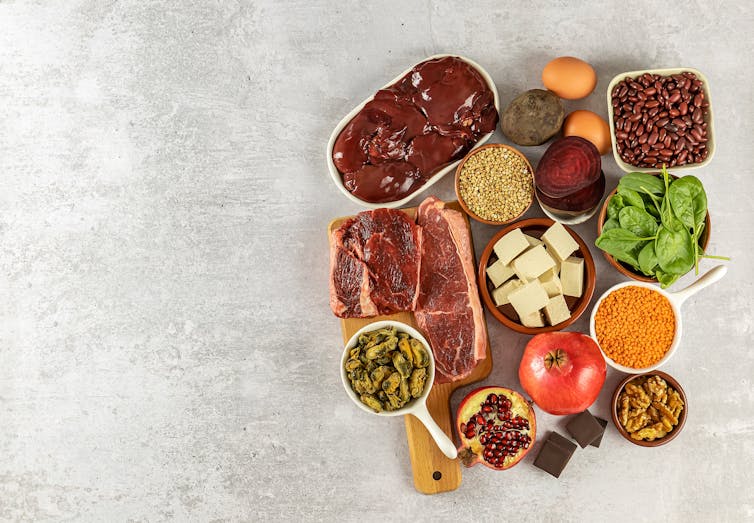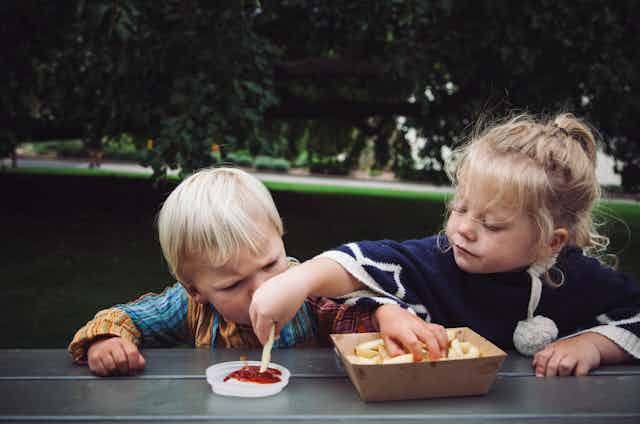Around 75% of infants aged six to 12 months and 25% of toddlers aged one to two years in Australia don’t get the recommended dietary intake of iron.
Despite their small size, weaning infants and children require similar amounts of iron to adults. The iron is crucial for supporting their rapid growth in blood and muscles, immunity, brain development and learning.
Untreated iron deficiency can progress to anaemia – severe iron deficiency where there are insufficient healthy red blood cells to carry oxygen around the body. Alarmingly, anaemia affects around 8% of Australian children under five, and if untreated, can be associated with developmental setbacks and later cognitive deficits.
Read more: Why iron is such an important part of your diet
How do I know if my kids have iron deficiency?
Iron deficiency in children is often associated with vague or no symptoms, especially if it has not progressed to anaemia.
Symptoms can include fatigue, difficulty concentrating, poor behaviour, frequent infections, and pica (eating non-food substances such as paper, clay or soil).
Diagnosis typically involves a blood test that screens for iron markers such as ferritin, a protein that stores iron. Doctors often recommend these tests for people who are at high risk, detailed in the figure below.
What are the first options for treatment?
When iron deficiency and anaemia are caused by a lack of dietary iron, both can often be effectively addressed through changes to the diet and oral iron supplements.
The Royal Children’s Hospital in Melbourne recommends boosting intake of iron-rich foods such as meat, fish, eggs, leafy greens and legumes, and drinking less than 500mL (about two cups) of cow’s milk per day. This is because cow’s milk has been associated with reduced iron stores in young children.
Doctors might also prescribe oral iron supplements. A course of liquid or tablets would usually be recommended for a minimum of three months , during which follow-up blood tests can show how well the child is responding to the supplementation.
Existing evidence suggests supplements are a more effective way to replenish iron stores than dietary changes alone, and ferrous sulfate is the most effective iron supplement for young children.

Navigating the side effects
Iron supplements are known to have some nasty side effects including constipation, nausea, diarrhoea, dark stools, and stained teeth. This may make compliance challenging, especially for young children. The approaches to alleviate side effects vary depending on the child.
The doctor may recommend alternative supplements as some may be better tolerated than others. Another option is to adjust the dosage, with lower dose supplements or taking it every other day.
Consuming iron supplements with food or immediately after eating can also lessen side effects. However this may result in reduced absorption, and should be discussed with your doctor.
For cases where iron supplements don’t appear to be working or where compliance is an issue, iron infusions may be prescribed by your doctor. These involve injecting iron over multiple visits at a hospital and/or specialist clinic, with each session potentially lasting an hour or more.
Read more: I've been diagnosed with iron deficiency, now what?
How can I prevent iron deficiency in my kids?
To prevent iron deficiency, it’s important to keep an eye on your child’s iron intake, and the factors that may influence their absorption.
For example, drinks which contain tannins (tea, coffee, chocolate drinks) may inhibit iron absorption. But vitamin C and organic acids from fruits and vegetables, as well as high-quality proteins such as those found in meat and fish, can promote absorption.
From infancy, following the national feeding guidelines will help to support your child’s iron status. This includes introducing iron-rich solid foods from around six months of age for healthy breastfed infants to replenish their iron stores from birth.
Around six months is also the prime time for introducing foods to minimise risk of food allergies, including to iron-rich foods such as seafood and nut butters.
From 12 months onwards, children’s diets should align with the Australian Dietary Guidelines, emphasising a balanced, nutritious diet encompassing a range of foods. Diets following this pattern should deliver ample iron from meats, breads and cereals, as well as iron absorption promotors such as oranges, capsicum and other fresh fruits and vegetables?.
In cases where the child is a picky eater, or where access to a diversity of foods is limited, look for fortified iron options such as in bread, drinks (for example juice for kids over 12 months, and Milo for older kids), and breakfast cereals.
If your child is diagnosed with iron deficiency, remember each path to recovery is unique. Consultation with a GP or dietitian can help tailor solutions catering to their specific needs.
Read more: What to drink with dinner to get the most iron from your food (and what to avoid)

